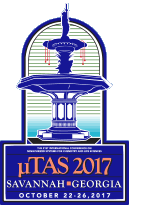  |
Workshops Workshop 1 Workshop 2 Workshop 3 Workshop 4 Workshop 5 Workshop 6 Workshop 7 Workshop 8 Workshop 9 Workshop 10 Workshop 11 |
Workshop 6 (Morning 9:00 - 12:00) Title: NETWORKED LOCS: A PASSIVE ROUTING CONCEPT FOR TWO-PHASE-FLOW MICROFLUIDICS Presenters: Werner Haselmayr, Johannes Kepler University Linz, AUSTRIA Robert Wille, Johannes Kepler University Linz, AUSTRIA Andreas Grimmer, Johannes Kepler University Linz, AUSTRIA Workshop Description: Droplet based two-phase flow microfluidic systems provide a promising platform for the realization of Labs-on-Chips (LoCs). Here, samples e.g. of DNA, proteins, cells, as well as organisms are injected into droplets. Then, these droplets flow in an immiscible continuous flow inside closed channels and are passed through modules executing operations such as mixing, heating, and detecting -- realizing the desired medical/biochemical experiment. The use of closed channels allows for a long-term incubation and storage of droplets. However, existing approaches still suffer from a rather complex control-layer (i.e. for controlling modules based on dielectrophoresis or valves) and/or lack in flexibility (i.e. are designed for a specific laboratory experiment only). These problems have recently been addressed by extensions to passively route droplets through the system -- allowing for a dynamic/conditioned behavior within one experiment and the support of different complex experiments on the same chip. This eventually results in a concept known as Networked Labs-on-Chips (NLoCs). Networked Labs-on-Chips exploit hydrodynamic forces acting on droplets. More precisely, when a droplet arrives at a bifurcation, it will flow along the successor channel with the lowest hydraulic resistance (defined by the channel's geometry). By that, the droplet itself increases the channel's hydraulic resistance and, therefore, temporarily blocks this channel for following droplets. This principle of selectively blocking channels is eventually used to route droplets through the NLoC, and, hence, to increase the flexibility, effectiveness, as well as re-usability of the microfluidic system. The aim of this workshop is to introduce this novel and exciting approach for LoCs to a wider audience as well as to present and discuss existing solutions and challenges with respect to their application, realization, and efficient design. Outline:
|